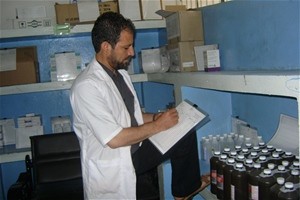
Pharmacist Zakhi Ahmad Qiami records medicines on a stock card in the pharmacy at the Indira Gandhi Children’s Hospital in Kabul.
Lutfullah Ehsaas
Drug and Therapeutic Committees give doctors, administrators, and pharmacists tools to make better use of drugs, improving patient care.
11 OCTOBER 2010 | KABUL, AFGHANISTAN
Prescribing too many antibiotics, wide discrepancies in treatment practices among doctors, lack of attention to drug interactions, and an unclear picture of what medicines are needed are problems that plague hospitals in Afghanistan. “We had no treatment guidelines and information about available medicines, so each of us was prescribing in different ways and often prescribing multiple antibiotics at one time. We never knew whether the medicines we prescribed were actually in the pharmacy and there was also no follow-up of discharged patients,” said Dr. Mohammad Sharif Sailani, a pediatrician at Kabul’s Indira Gandhi Children’s Hospital.
Three Afghan hospitals, the Indira Gandhi Children’s Hospital, the Noor Eye Hospital, and the Stomatology Dental Hospital are solving these problems. These hospitals each have a Drug and Therapeutics Committee (DTC) made up of administrators, doctors, and pharmacists who work at that hospital. Each DTC meets regularly and has agreed to develop a formulary list and improve stock management in their pharmacy. The DTC decides which drugs to order and certifies that only safe, cost-effective, and good quality medicines are used.
“Our hospital’s pharmacy has been completely re-organized with stock cards to record the supplies. Daily and weekly tally sheets are filled out to track medicine use, so now we know what we have on hand,” said Zakhi Ahmad Qiami, a hospital pharmacist. The DTCs in Noor Eye Hospital and Stomatology Dental Hospital have recognized the need for standard treatment guidelines to rationalize clinical therapy and have embarked on a one-year plan to draft these guidelines.
When asked what difference the DTC is making, Dr. Sailani said, “It is improving the care we give our patients. Children are receiving better treatment, recovering more quickly, and being discharged with information that allows for better follow-up.”







Comment
Make a general inquiry or suggest an improvement.